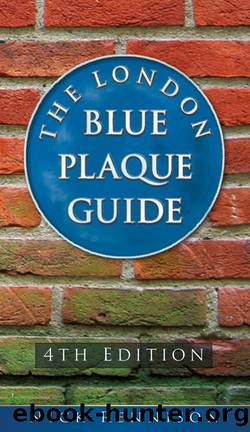The London Blue Plaque Guide by Nick Rennison

Author:Nick Rennison [Rennison, Nick]
Language: eng
Format: epub
ISBN: 9780752499963
Publisher: The History Press
Published: 2015-07-02T00:00:00+00:00
In a house on this site, The Swan and Hoop, JOHN KEATS, poet was born 1795
MOORGATE PUBLIC HOUSE, 85 MOORGATE, EC2
CITY OF LONDON
On this site formerly stood the cottage in which the poet JOHN KEATS served apprenticeship (1811â1815) to Thomas Hammond, a surgeon of this parish
3 KEATS PARADE, CHURCH STREET, N9
BOROUGH OF ENFIELD
On this site poet and apothecary JOHN KEATS and his friend, the poet, apothecary, surgeon and chemist Henry Stephens shared lodgings while studying at Guyâs and St. Thomasâ Hospitals (1815â1816)
8 ST THOMAS STREET, SE1
GUYâS AND ST THOMASâ CHARITIES FOUNDATION
Keats was born in London and went to school in Enfield. After leaving school he was apprenticed to an apothecary and he was himself licensed to practise in the profession, but chose to abandon it and concentrate on the writing of poetry. His first volume of verse was published in 1817 and attracted some favourable attention. It was also one of the targets of a vicious and snobbish critical assault by Blackwoodâs Magazine on the alleged literary and social pretensions of what the magazine termed the âCockney Schoolâ of poetry. Keatsâs younger brother Tom died of tuberculosis the following year and Keats, who had nursed him and was showing symptoms of the disease himself, moved into a house in Hampstead owned by a friend, the house now known as Keats House. It was at this time, despite ill health and the complications of his love for Fanny Brawne, who was living, with her family, next door, that Keats entered upon an extraordinary period of creativity, writing most of the poems, including âOde to a Nightingaleâ and âOde on a Grecian Urnâ, by which he is best remembered. However, he continued to grow sicker throughout the following two years and, after a last journey to Italy in search of a climate kinder to his tuberculosis, he died in Rome in 1821.
KELLY, SIR GERALD (1879â1972) portrait painter, lived here 1916â1972
117 GLOUCESTER PLACE, W1
Gerald Kelly was a portrait painter to the establishment. Educated at Eton and Cambridge, he studied art in Paris and, uninterested in the experiments of the modernists, soon began to make his name in his chosen field. He was elected a Royal Academician in 1930 and became President of the Royal Academy for five years in the early 1950s. Among his best-known works are the state portraits he painted of George VI and his wife, the Queen Mother, in 1945, the year Kelly himself was knighted.
KELVIN, LORD (1824â1907) physicist and inventor, lived here
15 EATON PLACE, SW1
Born in Belfast, the son of a mathematics professor, William Thomson moved with his family to Glasgow in 1832. He attended university there and then studied at Cambridge before returning to Glasgow as Professor of Natural Philosophy at the exceptionally early age of twenty-two. He remained in the post for more than half a century. Thomson was one of the most gifted exponents of both pure and applied science in the nineteenth century. He is remembered particularly as the man whose researches led to the
Download
This site does not store any files on its server. We only index and link to content provided by other sites. Please contact the content providers to delete copyright contents if any and email us, we'll remove relevant links or contents immediately.
| Great Britain | General |
| Bath | Devon |
| Gloucestershire | London |
| Yorkshire |
Spell It Out by David Crystal(36044)
Underground: A Human History of the Worlds Beneath Our Feet by Will Hunt(12027)
A Year in the Merde by Stephen Clarke(5326)
Venice by Jan Morris(2527)
Claridge's: The Cookbook by Nail Martyn & Erickson Meredith(2359)
My Paris Kitchen: Recipes and Stories by Lebovitz David(2259)
A TIME OF GIFTS by Patrick Leigh Fermor(2156)
The Plantagenets by Dan Jones(2041)
Welcome to the Goddamn Ice Cube by Blair Braverman(1993)
The Finnish Way by Katja Pantzar(1940)
Top 10 Prague (EYEWITNESS TOP 10 TRAVEL GUIDES) by DK(1933)
From Russia with Lunch by David Smiedt(1933)
Bang Poland: How To Make Love With Polish Girls In Poland by Roosh V(1925)
The Isle of Mull by Terry Marsh(1899)
A TIME TO KEEP SILENCE by Patrick Leigh Fermor(1865)
Rick Steves London 2018 by Rick Steves & Gene Openshaw(1823)
Insight Guides Experience Tokyo by Insight Guides(1816)
A Taste of Paris by David Downie(1813)
Merde in Europe by Stephen Clarke(1726)
